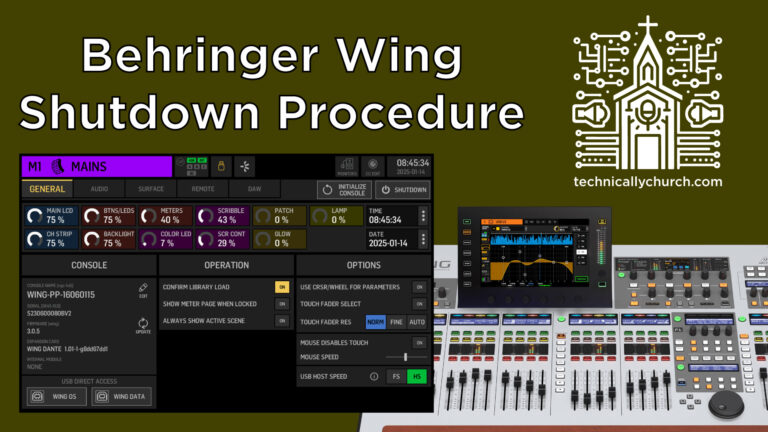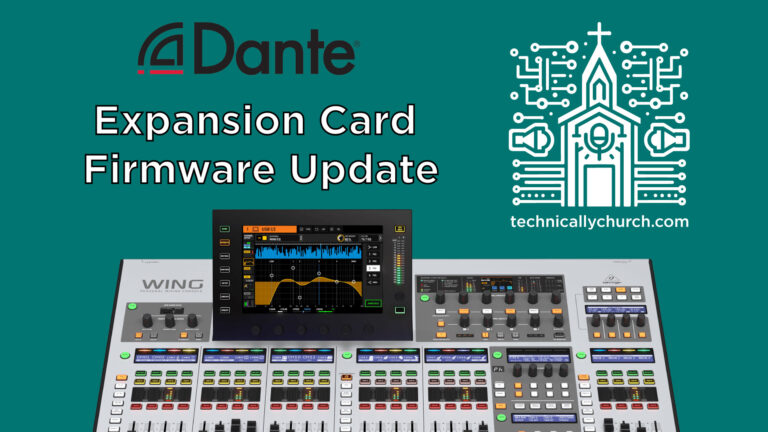How to Send Reverb to Vocalist In-Ears Using the Behringer WING
Introduction
One of the most common questions audio engineers working in worship tech ask is:
“How can I get reverb into my vocalist’s in-ear monitors?”
Adding reverb can help vocalists feel more comfortable when performing, especially in dry or acoustically treated environments. The Behringer WING digital sound console offers flexible routing options that make this possible. In this article, we’ll walk through a streamlined and DSP-efficient way to send reverb into vocalist monitors without cluttering your setup or burning through your effects slots.
We’ll cover:
- Why a dedicated bus works best for reverb
- How to set up and route a reverb effects bus
- How to get it into your vocalist’s in-ear monitor mix
This procedure uses the Behringer WING full-size console, but the concepts apply similarly to other digital desks.
Why Use a Dedicated Reverb Bus?
You might be tempted to insert reverb directly on each vocal channel. While technically possible, this approach is highly inefficient because:
- You’ll use more DSP—each insert effect occupies one rack slot.
- It’s hard to manage overall vocal reverb levels.
- It lacks consistency between channels.
The recommended approach is creating a dedicated reverb effects bus where all vocal mics are sent for processing. The reverb-processed signal is then blended with the dry vocals and routed to the main mix and/or in-ears. This gives greater flexibility and efficiency.
Step-by-Step Guide
Step 1: Set Up a Reverb Bus with Effects
Create a Bus for Reverb
- On the WING, set up a Mix Bus (e.g., Bus 1).
- Name it something like “Vocal Reverb” for easy recall.
Insert a Reverb Effect
- Press the “HOME” button.
- Navigate to the Effect Rack.
- Choose an available FX slot and select a Reverb effect from the library (e.g., Vintage Reverb, Plate, or Room).
- Set the input source to Bus 1, and the output to either dedicated FX Returns or directly route it to another Bus.
Send Vocal Mics to the Reverb Bus
For each vocal channel:
Select the channel > Press “SENDS” > Locate Bus 1
Enable the send and adjust the level to control how much of that mic’s signal goes to the reverb.
Tip: Use “Sends on Fader” mode to speed up this process:
- Press the SOF (Sends on Fader) button.
- Select Bus 1 (your vocal reverb bus).
- Your faders are now controlling send levels to Bus 1. Move vocal mic faders up/down to adjust reverb send levels.
Step 2: Route the Reverb Bus to the Vocalist’s In-Ears
The issue many engineers run into is that ‘Sends on Fader’ doesn’t give you direct access to other buses within that mix. So how do we get Bus 1 (our reverb) into the in-ear monitors (e.g., Bus 6)?
Here’s how:
Select the Reverb Bus (Bus 1)
- Press the “Bus” button or access it through the home screen.
Route Bus 1 to the In-Ear Bus (e.g., Bus 6)
- While Bus 1 is selected:
- Navigate to the SENDS section.
- Scroll to Bus 6 (your vocalist’s IEM bus).
- Turn the send ON and bring the level UP to taste.
- While Bus 1 is selected:
What’s happening here is that you are sending the reverb-processed signal itself into the monitor mix, not just dry vocals. This way, vocalists can hear the spaciousness and echo they’d expect in a live room—even through isolated in-ears.
Quick Visual Summary (Signal Flow)
- Vocal Channels → Sent to Bus 1 (Vocal Reverb)
- Bus 1 → Insert Reverb FX
- Bus 1 → Sent to:
- Mains (optional)
- In-Ear Bus (e.g., Bus 6)
Monitoring and Final Adjustments
- After routing, test the in-ear monitors:
- Ask vocalists to give feedback on how much reverb they need.
- Adjust the send level from Bus 1 to Bus 6 accordingly.
- Keep an eye on FX return levels if you route them through separate channels to avoid muddy mixes.
Tips and Best Practices
- Use Pre-Fader Sends to Bus 1 if you want the reverb level to stay consistent even when adjusting the vocalist’s main fader.
- Group background vocalists if they share similar reverb needs.
- Use high-pass filtering on the reverb send or return to avoid muddy low-end build-up.
- Don’t overdo reverb in in-ears — it can create a washed-out sound that hinders timing and pitch accuracy.
Conclusion
Adding reverb to a vocalist’s in-ear mix on the Behringer WING is both simple and powerful when using a dedicated effects bus. This workflow saves DSP resources, enhances consistency, and provides much-needed space in the monitor mix without sacrificing clarity.
Whether you’re mixing for Sunday worship or a full-scale production event, this approach will offer your vocalists a more natural and confidence-building experience on stage.
Ready for the next level?
In upcoming tutorials, we’ll tackle sending stereo in-ear mixes using panning, using Waves plug-ins on the WING via Dante, and how to multitrack record and mix with Adobe Audition.
Stay tuned and subscribe for more worship audio production tips!







